
- Introduction to Angular Canvas component
- Language structure
- How does part function in Angular Canvas?
- Precise JS
- A pictorial portrayal of a few significant pieces of Angular JS.
- Elements and employments of Angular JS
- Scope
- Benefits and Disadvantages of Angular JS
- What is Binding and various kinds of restricting in Angular 4?
- What is the distinction among Components and Directives in Angular 4?
- What is Typescript and how might it be valuable in Angular 4?
- What are Components in Angular 4?
- What are the Modules in Angular 4?
- What is Routing in Angular 4?
- What are the Directives in Angular 4?
- What are separated unit tests in Angular 4?
- What are Services in Angular 4?
- What is Dependency Injection (DI) in Angular 4?
- Conclusion
- Precise gives different parts which can be utilized to make the Ui part which incorporates buttons, symbols, popups,s, and some more. In any case, we have arrangement by which we can make our custom part too, yet this can be made by utilizing Angular too.
- To utilize any of the precise part we must have the Angular Canvas library set up, after that we can utilize the module which can be utilized to make the different sort of part on our UI which accompanies the default liveliness and planning and make the Ui more easy to use. In the approaching segment of the instructional exercise we will see the means needed to involve part of Canvas inside our application for amateurs.
Introduction to Angular Canvas component :-
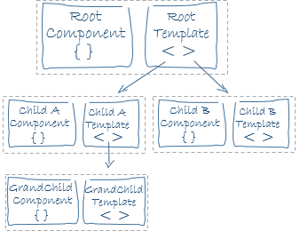
Language structure :-
As we definitely realize that, to make the UI we need to utilize these part, which we will use in the approaching segment of the instructional exercise. we should initially see the grammar we make the part in the Canvas or Angular application see beneath;
- @Component({
selector: elector name’,
templateUrl: ‘html file path or name’,
})
We can make custom part in Angular by demonstrating the augmentation as ‘.ts’ additionally we can utilize the current part from the Canvas library. to make the UI for the application. to utilize the current one we can undoubtedly import the module and begin utilizing the part.
How does part function in Angular Canvas?
In Angular Canvas, we have different kind of part accessible which give different sort of usefulness to the client and UI. In this activity we will see steps to utilize those compound inside the precise application how about we get everything rolling see underneath;
1. MatButtonModule: Canvas give us “MatButtonModule’ which assists us with making the button without default styling and planning. it resembles basic button component however concocts default activity. we need to import this module inside our root module document by which we will be accessible to utilize the part and the selector on the format;
2. MatButtonToggleModule: this is the another part give by the Canvas library. We need to import this likewise inside the root module to utilize this. This button addresses on/off appearance to the button in short switch appearance. for reference see the beneath import for this module;
3. MatCardModule: This is additionally another part which go about as the holder to address other elemnent together. We need to import the underneath bundle to utilize this;
4. MatCheckboxModule: this is utilized to make the checkbox for our application. Import this inside the root module for reference see the underneath code; There are such countless Canvas parts which given by the Canvas library we can utilize any of them.
Presently how about we investigate the venture creation for the Angular Canvas and steps which should be taken see underneath;
1) First we need to introduce the precise CLI which can be utilized to assemble, run and make the Angular task from the scratch. follow the underneath order to introduce the CLI internationally and utilized from anyplace from the framework see beneath;
2) presently we can make the task utilizing the CLI, simply execute the beneath order with the name indicated. Additionally we can see the task structure once it gets made see underneath;
3) Now we can run the underneath order to introduce the reliance and it will make the hub module organizer or us, this envelope will contain the reliance;
4) after this we can begin the server and see the progressions just by executing the beneath order.
5) presently we can run the application utilizing the beneath URL , recollect the default port for precise is 4200, yet we can transform it while making the venture for Angular;
6) introduce the Canvas library utilizing the beneath order. After this effective establishment we can capable be utilized the part given by the Canvas library After this we are prepared to make our first part utilizing the Canvas library.
- Precise JS was made in 2009 as a side venture by two engineers, Misko Hevery and Adam Abrons. The two had initially begun the task to construct a start to finish apparatus that permitted website specialists to connect with both the frontend and the backend.
- It is written in JavaScript. The beneficial thing and the justification for Angular to be famous in the market is that it has a bunch of prepared to-utilize modules to work on the structure of single-page applications.
- Precise JS follows the MVC structure. We as a whole realize MVC represents Model View Controller and is one of the well known programming configuration designs for creating web applications.
- Presently there comes an inquiry that what is Model View and Controller really addresses in Angular JS.
- Model − It is the most minimal level of the example liable for keeping up with information.
- Regulator – It is the parts and orders. We will examine this in later areas.
- View – The format (HTML) handled by Angular and the program goes under the view.
- Precise JS has many elements that we will examine later in the segment.
- Out of its many elements, highlights like information restricting and reliance infusion kill a significant part of the code presently one needs to compose without utilizing Angular JS and everything occurs inside the program, which makes it an optimal collaborate with any server innovation.
Precise JS :
A pictorial portrayal of a few significant pieces of Angular JS.
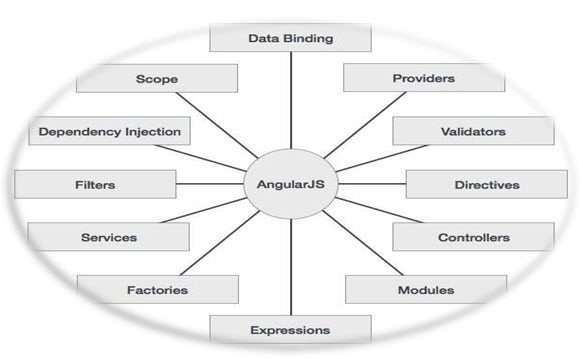
- ng-application, ng-init, ng-model.
- Information restricting
- It is the synchronization between the model and the view.
- ng-tie and ng-model mandates give the usefulness of information restricting.
Elements and employments of Angular JS :-
There are a few advantages of utilizing Angular JS. Kindly view as the beneath segments, where Angular JS has been utilized generally and viably. The following is the rundown of top employments:
Mandates :
Mandates are markers on DOM components (like components, traits, CSS, and the sky is the limit from there). It has a bunch of inherent mandates which offers usefulness to your applications. We can likewise make our own mandates in Angular JS. A portion of the inherent orders are as per the following:
- These are objects that allude to the model.
- The degree is the limiting part between the HTML (view) and the JavaScript (regulator). It is an item with the accessible properties and techniques and is accessible for both the view and the regulator.
- In this way, so, it is the associating part between a regulator and the view. A degree is utilized with $scope in Angular JS.
- Assuming we make a regulator and a contention to be passed, it is conceivable with a $scope. Then, at that point, just the view (HTML) gains admittance to these properties.
- The regulators control the information of Angular JS applications.
- Regulators are ordinary JavaScript Objects.
- Uses of Angular JS are constrained by regulators.
- The regulator is characterized with ng-regulator
- An assistance is a capacity, or item, that accompanies Angular JS.
- We can likewise make out assistance for the use of Angular JS.
- The extent of the assistance is restricted to the application.
- There are very nearly 30 inbuilt administrations accessible with Angular JS.
- $area: It is only an option in contrast to “widow.location” how we treat HTML.
- $http: It makes a solicitation to the server, and allows the application to deal with the reaction.
- Channels: Filters are utilized in Angular JS to organize information. We can likewise make our own channels by enrolling another channel industrial facility work with your module.
- Formats: It gives the watcher data from the regulator and model.
- Steering: It assists with exchanging sees. In Angular JS application with ngRoute modules assists the application with changing to various pages without stacking the whole application.
- Model View: As it is as of now clarified over that Model the most minimal level of the example answerable for keeping up with information and View addresses the format (HTML) handled by the Angular application and the program.
- Profound Linking: It permits encoding the condition of an application in the URL so it very well may be bookmarked. The application can then be reestablished from the URL to a similar state
- Reliance Injection: Dependency Injection is a product planning design which manages how parts get hold of their conditions.
- In Angular JS, injector subsystem is liable for making the part, settling their conditions and giving the conditions to different parts as required.
Scope :-
Regulator:
Administrations:
Models-
Followings are not many channels given: cash, date, channel, json, limitTo, lowercase, number, orderBy, capitalized.
- Straightforward and Improved Design Architecture.
- DOM control.
- Lesser code to compose.
- Further develop Development Efficiency.
- Code Reusability.
- A code is Unit Testable.
- Permit Dependency Injection.
- Two-way information restricting.
- Capacity to make custom mandates.
- Arrangement for channels.
- Not Secure. Server-side verification and approval are needed to keep the application secure.
- Not degradable. It intends that on the off chance that the JavaScript is impaired, the watcher will see the fundamental pages.
- JavaScript support is obligatory.
- Trouble in learning.
- So we have learned employments of Angular JS and a few nuts and bolts data. We have additionally gone over its couple of its many pieces, which assist us with learning some information about it.
- We have likewise gone over its upsides and downsides of it which one should remember which picking Angular JS for the application. It is one of the moving business sector advancements in this day and age.
Benefits and Disadvantages of Angular JS :-
The following are the benefits and impediments:
Benefits :
It has coming up next are the couple of benefits:
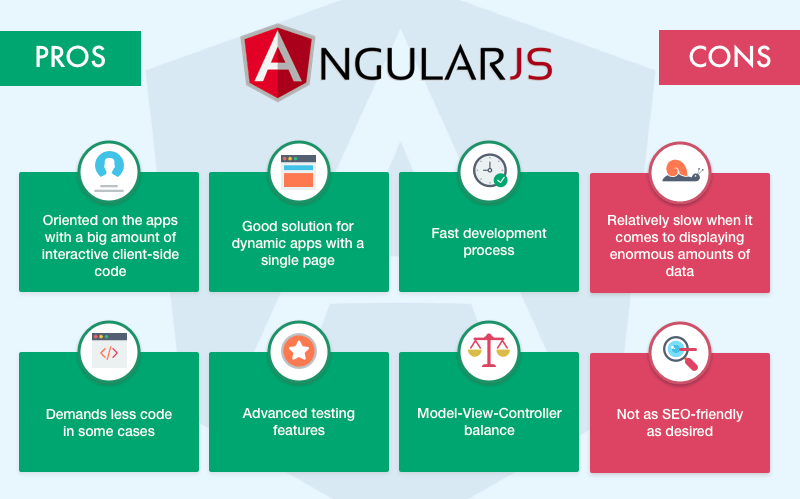
Inconveniences :
Following are the couple of inconveniences which one should remember:
1. What is Binding and various kinds of restricting in Angular 4?
The method involved with restricting in Angular 4 is a course of building up synchronization between the View and Model Components which are various layers in the application.
The element of information restricting is accessible since Angular 2. The various types of restricting are Two Way restricting, Event restricting, and Property restricting. This information restricting is a significant and key variable in Angular parts.
Two-way restricting is the mix of Occasion restricting and Property restricting highlights where Event restricting is characterized as the most common way of refreshing the upsides of a variable or trait from View part layer to Model Component Layer and Property Binding is characterized as the method involved with refreshing the of a variable or quality in Model part and showing the qualities in View part.
- The Components in Angular 4 are characterized as the fundamental classes which interface with the page parts, for example, HTML documents or UI components.
- The parts will be characterized as Components utilizing Decorators. Every single part will be assigned with a predefined layout. A Class can be characterized utilizing an Angular Directive to create it a Directive that can be utilized at show time to handling and launching.
2. What is the distinction among Components and Directives in Angular 4?
3. What is Typescript and how might it be valuable in Angular 4?
Typescript is a broadly useful programming language created by Microsoft and furthermore a superset of JavaScript programming language. Angular 4 system is totally based on top of Typescript language.
Typescript is an essential language utilized in Angular which is being treated as a top of the line resident.
Typescript can be utilized to foster Angular applications and the code will be transpiled later utilizing transpilers to help numerous or various renditions of program stages.
- This is the normal Angular 4 Interview Questions that are asked in a meeting. The Components in Angular 4 are characterized as the fundamental classes which collaborate with the website page parts, for example, HTML record. The parts will be characterized as Components utilizing Decorators.
- Every single part will be assigned with a predefined layout. A part can be characterized utilizing @Component which is called as Decorator.
- The selector, style, and format can be characterized inside the part to carry out additional usefulness.
4. What are Components in Angular 4?
5. What are the Modules in Angular 4?
A Module in Angular is characterized as the document where every one of the Directives, Components, Pipes and Services are assembled and interlinked together to make it an ideal working Angular application.
Each Angular application has a root module that will be characterized inside app.module.ts which is the Typescript record design. To characterize a module in Angular 4, NgModule can be utilized.
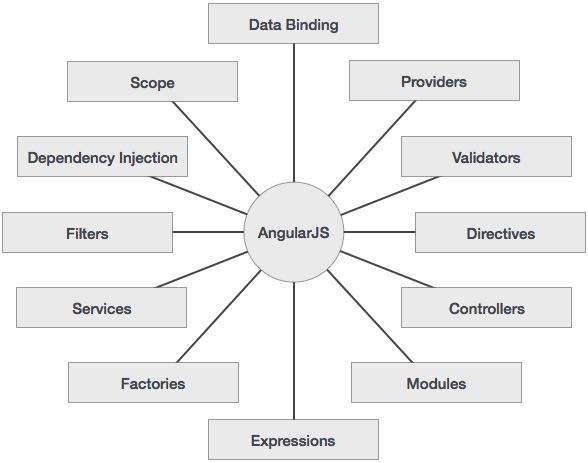
- Directing in the Angular application is the method involved with applying courses to various parts to show the substance of the part characterized mostly in Single Page Applications.
- This steering arrangement can be characterized in the root AppModule. The Router usefulness in Angular empowers the clients to explore from one errand to various different undertakings while playing out numerous functionalities.
- A Route is characterized as the application by planning the URL to the various parts.
6. What is Routing in Angular 4?
- The Directives in Angular 4 can be characterized as the lengthy HTML credits which can be characterized as custom ascribes.
- The Directives in Angular 4 can be pre-characterized or can be Custom characterized to control the usefulness of DOM components.
- There are three various types of Directives in Angular 4, they are Components, Structural Directives and Attribute Directives.
- The Components are only orders with a layout. The Structural Directive is characterized as which changes the DOM structure by adding or eliminating the DOM components. The Attribute Directives are characterized as an adjustment in the conduct of a part, or a component or some other mandate.
7. What are the Directives in Angular 4?
8. What are separated unit tests in Angular 4?
This is the much of the time asked Angular 4 Interview Inquiries in a meeting. The Isolated Unit Test is characterized as the most common way of performing tests on a part or class in a segregated manner rather than setting up any reliance with different parts.
It implies that testing will be performed in view of each individual part and component in separation. Segregated Unit Tests are valuable in testing the Angular Services and Pipes.
The most common way of creating pipes in Angular which will be changed into various types prior to being shown needs cautious testing to deliver productive information tasks among Model and View parts.
- The Services in Angular is characterized as the most common way of involving the center usefulness of different Components in a single part.
- The applications, for example, information associations that should be used across various parts can be accomplished by involving the Services in Angular 4.
- The method involved with introducing the information from Model to View or the other way around is set up by utilizing Services. Administrations are awesome of applying correspondence across various classes that don’t have the foggiest idea about one another.
9. What are Services in Angular 4?
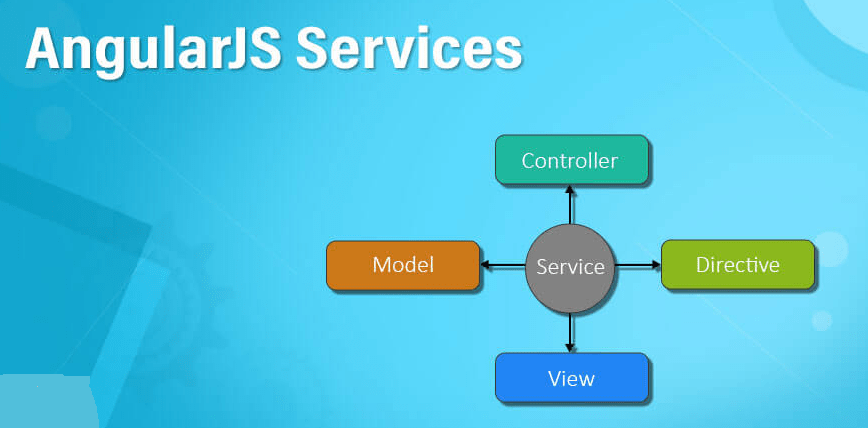
10. What is Dependency Injection (DI) in Angular 4?
The Dependency Injection in Angular 4 is characterized as the method involved with secluding the conditions and tight coupling across various parts.
This will hold the conditions of parts in different parts. Precise Dependency Injection is the approach to making objects which rely upon different articles.
The occurrences of different parts will be made or infused into another part utilizing the Injection include.
Conclusion :-
As from the article we have seen that we can without much of a stretch make our custom part additionally we can utilize the current one given by the Angular Canvas. follow the previously mentioned steps in the article it is extremely simple to make, keep up with and handle by the engineers too.






